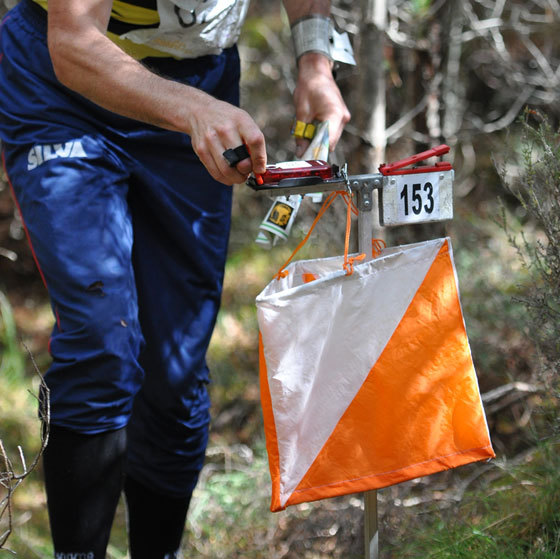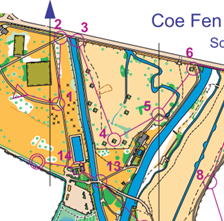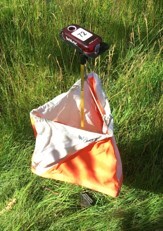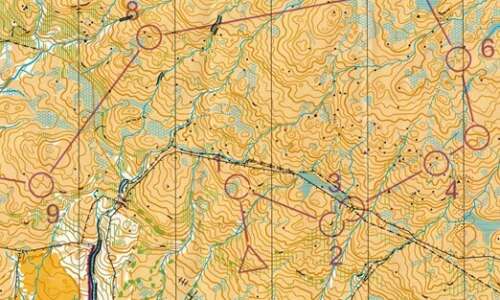New to Orienteering?An overview of the sport
- Home >
- Information >
- New to Orienteering?
If you haven't tried orienteering before or are not very experienced, we hope the explanations below will answer your questions. We lay on events, and in addition you can still take a look at our permanent and virtual courses, for activities you can do at a time of your own choosing.
If you are looking forward to having a go at something local in the Cambridge area then head over to our Park-O pages.
If you have a question for us, send an email to the club chair (see the contact page for the address).
Orienteering
Orienteering includes a wide range of activities including MapRunning, walking or jogging round a Permanent Orienteering Course as a family, Adventure racing, City races, indoor orienteering in multi-storey buildings, as well as "cross country" orienteering in forests and woodland.
You participate as an individual, pair, or group, more or less independently. In an organised event, start times are spaced out so you can't just follow or be followed by other participants. Even highly competitive orienteers don't generally run head to head against each other, although they can compare their results and route choices after they finish.
To find out more about the various flavours of orienteering, follow these links:
MapRun - anytime smartphone orienteering
POCs - Permanent Orienteering Courses
Events - organised meetings where a range of courses are on offer
Park-O - Events specially designed for newcomers and school age juniors
You can see a list of forthcoming events on our events page.
The basics
In any form of the sport, the aim is to navigate between control points marked on a special orienteering map and decide the best route to complete the course in the quickest time. It does not matter how young, old or fit you are, as you can run, walk or jog the course and progress at your own pace.
On the map, control sites are marked by circles and on the ground, by orange and white flags (unless you are running a virtual course in which case there is no physical marker). Courses vary in length from less than 2km to over 12km and some larger events also have a string course, which toddlers and young children can follow safely through a patch of forest.
Starts are typically staggered with each person/group starting at least one minute after the previous starter on that course. The starts typically operate over a two-hour period, so whilst you are actually out in the forest the other competitors do not know how badly or well you are doing. The staggered start also helps families: One adult can take the child/children around the string course or short course whilst the second adult competes, and still have time to compete themselves.
Orienteering can take place anywhere from forest and open countryside to urban parks and school playgrounds.
To start orienteering all you need is a sense of adventure and a pair of trainers. It's a great sport for runners, joggers and walkers who want some added interest for their excursions or to improve their navigation skills, or for anyone who loves the outdoors.
The British Orienteering website has excellent resources for newcomers.
The challenge of the sport can come as a surprise even to those newcomers who are very sporty or adventurous - read this posting on Mudstacle.
Orienteering is good for you - The health benefits are detailed here.
Sport for All
Orienteering caters for everyone. Whilst elite orienteers run at speed through complex terrain, reading the map as they go, families or groups frequently tackle courses together, with the children rushing ahead to punch at the control with the adults keeping an eye on the general direction, and maybe providing the motor power towards the end of the course!
Every event has a range of courses. As well as sometimes providing a string course for the very young, there will be courses suitable for 6 year-olds and upwards to tackle by themselves. At the other extreme, there are long, technically demanding courses for fit, experienced orienteers. The older age groups are also catered for, with courses which are still technically challenging but less physically demanding.
We lay on various levels of event depending from informal fun events to (very occasionally) national championships. At Local and Regional events (level C and D) you can usually enter whichever course you choose. Larger scale Level B (National) events offer an extended range of courses and you might compete according to age and gender. In this case, for each age-group there will be male and female courses, possibly with short and long options. Womens' courses are typically shorter that the corresponding mens' course, in order to give a similar winning time.
Orienteering appeals to both men and women, with women making up 40% of the competitors, more than for most outdoor sports.
The video below shows orienteers in action.
Come to an event
You can find out what happens at our Park-O events here, and organised events in general here.
Event Types
There are several forms of Orienteering events:
Colour coded events - These are the most common type and are typically set in woodland or parkland. Several courses will be on offer with different colours to indicate length and technical difficulty. Although the simplest and shortest are intended mainly for juniors, anyone can enter any course. The map will show a sequence of controls which must be visited in the order given. The fastest to correctly complete the course is the winner.
Urban events - these also offer a range of courses for different skill levels and ages, but are set in streetscapes, sometimes involving multiple levels. The courses are not usually colour-coded in this case but they operate in the same way - pick up a map and navigate to the controls in the correct order in as short a time as you can. In urban terrain only those 16 and older are allowed to enter courses that involve proximity to traffic; junior courses at these events are planned to avoid roads. Our MapRun League events often use urban areas.
Score events - In a score event a large number of controls will be shown on the map. The idea is to visit as many as possible within a time limit. The "score" is given by the number of controls visited less any penalty for being over the time limit.
Park-O, Summer Series, and "Come and try it" events - These are aimed specifically at children and families who are new to the sport. These are on a more informal smaller scale, and are less competitive.
Night events Orienteering after dark, with a headtorch, can be a thrilling experience. Open heathland which might be a doddle in daylight becomes more challenging, and it is even more important not to get lost!
String course - These are laid on in addition to regular courses, at some larger events. They are intended for the very young. Follow the string to find the controls.
Relay events - There are several different types of relay but they usually involve several individual runs being combined into a single score.
We also help to set up and maintain Permanent Orienteering Courses which provide a way to try orienteering in your own time, and MapRun courses which allow individuals to run a course using a smartphone.
Colour-coded Course Standards
The table below gives an idea of the relative difficulty of the colour standards. These are the same all over the UK, and precise guidelines can be found in British Orienteering Rules. Although the age of children has been used as a guide for some of the easier courses, even adult beginners would benefit from going round an easier course first just to get the idea of map scale, symbols etc.
| Colour | Technical difficulty | Physical difficulty | Remarks |
| White | 1 | 1 | Suitable for young children of 7 to 8 when accompanied or older children on their own. All on paths |
| Yellow | 2 | 2 | A doddle for experienced 12 year olds. Some route choice, all on paths. |
| Orange | 3 | 3 | Controls on features a little way off paths or on line features. Adult beginners shouldn't attempt anything harder. |
| Light Green | 4 | 3 | Transitional course for improving skills. |
| Green | 5 | 3 | For those with good navigational skills but with limited energy or running speed |
| Blue | 5 | 4 | Longer than Green and shorter than Brown! |
| Brown/ Black | 5 | 5 | For very fit and competent navigators who are usually 16-plus. |
A good orienteer in good physical condition will travel at somewhere between 6 and 10 minutes per kilometre depending on the terrain.
Competitions
You do not need to be competitive to enjoy orienteering, but most orienteers take a great interest in how well they get on relative to their peer group, whether this is fighting for podium places or further down the field.
Most orienteering events are competitive with results based on finish times. Orienteers who are members of British Orienteering will automatically earn ranking points at each event they take part in, which allows comparison with others in the same age class in the whole UK or in the local region. WAOC has its own club league which operates on a similar basis but is just for club members, and where the best performers each year receive a trophy at our annual prizegiving. In addition we organise a League for our midweek evening MapRun events.
The East Anglian Region also organises leagues for urban and forest orienteering, with trophies for the best performers amongst the clubs in the region.
There are national leagues for urban events (SEOUL, Nopesport league), and general events (UK Orienteering league).
Some events are also competitions in their own right such as the annual East Anglian Championship, and national events such as the British Orienteering Championships, the JK, and the biannual Scottish 6 Days. WAOC competes in inter-club championships (the CompassSport Cup and Trophy, and the Yvette Baker Trophy for Juniors) where all participating club members can earn points for the team. Relay events provide a chance for small teams of orienteers to combine their talents and compete for their club at relay events such as the British Orienteering Champs and the JK, the Harvester night relays, and the Peter Palmer night relay for juniors.
When? Where? How much?
Most organised Orienteering takes place on Sunday mornings during the autumn winter and spring, and WAOC aims to put on an event every 4-6 weeks. Neighbouring clubs do about the same, so if you are willing to travel around East (and West) Anglia, you can find a suitable orienteering event most weekends. For a list of forthcoming fixtures, see our Fixtures list.
If you become hooked on the sport, there are events held all over the country, and many WAOC members frequently travel to places like the Lake District, the Peak District, the Yorkshire Moors, Scotland and Wales to compete on top quality terrain, or to city centres including London for a "City Race".
There are also some big festivals of Orienteering: two, three, or four day events at the major bank holidays; and a week-long event in Scotland, Wales or the Lake District during August. WAOC members will be seen at all these events.
Most Local (Colour-coded) events cost £8 for an individual adult, with individual children and students at £2-£3 . Regional events often cost £10 -£12 for the adult entry fee. Adults who are members of British Orienteering obtain a £2 discount off most entries. All the events are put on voluntarily by orienteers for orienteers, but the price reflects the costs of producing the special maps, and land access fees.
What do I need?
All you need to start Orienteering is some sensible outdoor clothing, not shorts (unless it is an urban course), and a good pair of walking shoes or trainers. If the weather is cold or wet, make sure that you have adequate protection. Maps are almost universally printed on waterproof paper nowadays A compass is useful, but not essential, and you can always borrow one at the event.
When you get more involved, you'll probably consider buying a good compass and fell-running (or similar) shoes. For a forest event, most orienteers wear tracksters with optional "bramble bashers" to protect the lower legs, a long sleeved top and perhaps additional layers according to the weather. WAOC has its own very stylish long and short-sleeved club tops made from hi-tech breathable fabric.
Improving
Orienteering is a sport where technique and experience counts for a great deal, and there is always something to learn form orienteering in a new area or on different terrain.
WAOC provides training for club members in the Cambridge area, in weekly mid-week training sessions, and we provide training for juniors by licenced coaches within the club and potentially as part of the East Anglian Junior Squad.
For juniors in particular, there are award schemes for successfully completing courses of different standards (see colour coded standards above). The badge scheme provides actual badges you can sew onto clothing etc, and in addition British Orienteering issues certificates to members for progress in navigation and speed.
You can find some tips on improving your own technique here on this website: here.





